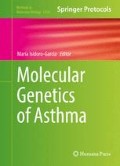Abstract
Exosomes are small extracellular vesicles of multivesicular bodies derived from the cell endosome. Molecules have a characteristic composition both in the membrane and in the carried load. These particles are located in the culture medium of cells in vitro and in vivo body fluids, being synthesized by almost all kind of cells. The most characteristic molecule transported within is the RNA with a large clinical potential. In this chapter, the methodology for isolation of exosomes and subsequent purification of the RNA is reviewed.
Access this chapter
Tax calculation will be finalised at checkout
Purchases are for personal use only
References
Mathivanan S, Ji H Simpson RJ et al (2010) Exosome: extracellular organelles important in intercellular communication. J Proteomics 73(10):1907–1920
Lee Y, EL Andaloussi S, Wood MJA (2012) Exosomes and microvesicles: extracellular vesicles for genetic information transfer and gene therapy. Hum Mol Genet 21(R1):R125–R134
Blanchard N, Lankar D, Faure F et al (2002) TCR activation of human T cells induces the production of exosomes bearing the TCR/CD3/zeta complex. J Immunol 168:3235–3241
Raposo G, Nijman HW, Stoorvoge W et al (1996) B lymphocytes secrete antigen-presenting vesicles. J Exp Med 183(3):1161–1172
Thery C, Regnault A, Garin J et al (1999) Molecular characterization of dendritic cell-derived exosomes. Selective accumulation of the heat shock protein hsc73. J Cell Biol 147(3):599–610
Wolfers J, Lozier A, Raposo G et al (2001) Tumor-derived exosomes are a source of shared tumor rejection antigens for CTL cross-priming. Nat Med 7(3):297–3037
Waldestrom A, Gennebäck N, Hellman U et al (2012) Cardiomyocyte microvesicles contain DNA/RNA and convey biological messages to target cells. PLoS One 7(4):e34653
Ronquist G (2012) Proteasomes are mediators of intercellular communication: from basic research to clinical implications. J Intern Med 271(4):400–413
Choi DS, Kim DK, Kim YK et al (2014) Proteomics of extracellular vesicles: exosomes and ectosomes. Mass Spectrom Rev 34(4):474–490
Caby MPD, Vincendeau-Scherrer C et al (2005) Exosomal-like vesicles are present in human blood plasma. Int Immunol 17(7):879–887
Pisitkun T, Shen RF, Knepper MA (2004) Identification and proteomic profiling of exosomes in human urine. Proc Natl Acad Sci U S A 101(36):13368–13373
Admyre C, Johansson SM, Qazi KR et al (2007) Exosomes with immune modulatory features are present in human breast milk. J Immunol 179(3):1969–1978
Admyre C, Grunewald J, Thyberg J et al (2003) Exosomes with major histocompatibility complex class II and co-stimulatory molecules are present in human BAL fluid. Eur Respir J 22(4):578–583
Vlassov AV, Magdaleno S, Setterquist R et al (2012) Exosomes: Current knowledge of their composition, biological functions, and diagnostics and therapeutic potentials. Biochim Biophys Acta 1820(7):940–948
Al-Nedawi K, Meehan B, Micallef J et al (2008) Intercellular transfer of the oncogenic receptor EGFRvIII by microvesicles derived from tumour cells. Nat Cell Biol 10(5):619–624
Szeles A, Henriksson M et al (2001) Horizontal transfer of oncogenes by uptake of apoptotic bodies. Proc Natl Acad Sci U S A 98(11):6407–6411
Holmgren L, Szeles A, Rajnavölgyi E et al (1999) Horizontal transfer of DNA by the uptake of apoptotic bodies. Blood 93:3956–3963
Lösche W, Scholz T, Temmler U et al (2004) Platelet-derived microvesicles transfer tissue factor to monocytes but not to neutrophils. Platelets 15(2):109–115
Schageman J, Zeringer E, Mu Li et al (2013) The complete exosome workflow solution: from isolation to characterization of RNA cargo. BioMed Res Int 2013:15 p
Théry C, Zitvogel L, Amigorena S (2002) Exosome: composition, biogénesis and function. Nat Rev Immunol 2:569–579
Janowska-Wieczorek A, Wysoczynski M, Kijowski J et al (2005) Microvesicles derived from activated platelets induce metastasis and angiogenesis in lung cancer. Int J Cancer 113:752–760
Lakkaraju A, Rodriguez-Boulan E (2008) Itinerant exosomes: emerging roles in cell and tissue polarity. Trends Cell Biol 18(5):199–209
Rajendran L, Honsho M, Zahn TR et al (2006) Alzheimer’s disease beta-amyloid peptides are released in association with exosomes. Proc Natl Acad Sci U S A 103:11172–11177
Peinado H, Alečković M, Lavotshkin S et al (2012) Melanoma exosomes educate bone marrow progenitor cells toward a pro-metastatic phenotype through MET. Nat Med 18:883–891
Admyre C, Telemo E, Almqvist N et al (2008) Exosomes—nanovesicles with possible roles in allergic inflammation. Allergy 63:404–408
Suntres EZ, Smith MG, Momen-Heraviv F et al (2013) Therapeutic uses of exosomes. Exosomes Microvesicles 1:2013
Valadi H, Ekström K, Bossios A et al (2007) Exosome-mediated transfer of mRNAs and microRNAs is a novel mechanism of genetic exchange between cells. Nat Cell Biol 9:654–659
Huang X, Yuan T, Tschannen M et al (2013) Characterization of human plasma-derived exosomal RNAs by deep sequencing. BMC Genomics 14:319
Mathivanan S, Simpson RJ (2009) ExoCarta: a compendium of exosomal proteins and RNA. Proteomics 9:4997–5000
Kim DK, Kang B, Kim OY et al (2013) EVpedia: an integrated database of high-throughput data for systemic analyses of extracellular vesicles. J Extracell Vesicles 2:20384
Author information
Authors and Affiliations
Corresponding author
Editor information
Editors and Affiliations
Rights and permissions
Copyright information
© 2016 Springer Science+Business Media New York
About this protocol
Cite this protocol
Marqués-García, F., Isidoro-García, M. (2016). Protocols for Exosome Isolation and RNA Profiling. In: Isidoro García, M. (eds) Molecular Genetics of Asthma. Methods in Molecular Biology, vol 1434. Humana Press, New York, NY. https://doi.org/10.1007/978-1-4939-3652-6_11
Download citation
DOI: https://doi.org/10.1007/978-1-4939-3652-6_11
Published:
Publisher Name: Humana Press, New York, NY
Print ISBN: 978-1-4939-3650-2
Online ISBN: 978-1-4939-3652-6
eBook Packages: Springer Protocols

